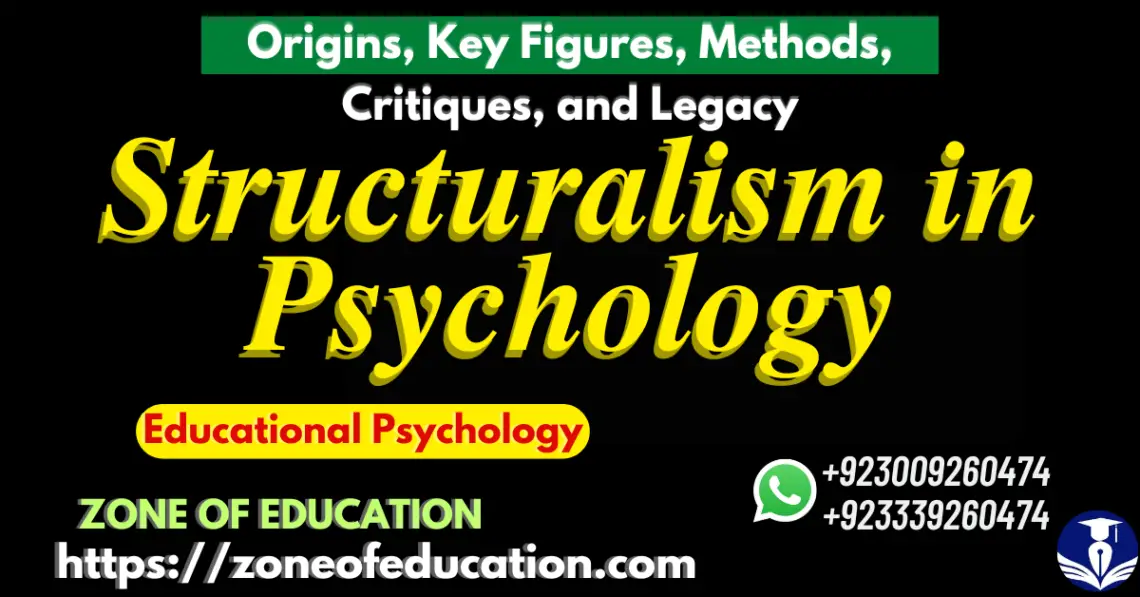Definition: Structuralism focuses on understanding the human mind by deconstructing it into its fundamental components, emphasizing the structure of consciousness and cognitive processes.
Historical Development: Structuralism originated in the late 19th century through Wilhelm Wundt’s experimental psychology, evolving under Edward B. Titchener’s formalization.
Key Figures: Wilhelm Wundt introduced introspection, while Edward B. Titchener formalized structuralist theories. Ferdinand de Saussure contributed with linguistic insights that influenced structuralist thought.
Methods: Structuralists used introspection and controlled experiments to analyze sensory experiences and mental processes, aiming to identify the basic elements of thought.
Criticism of Introspection: Introspection was criticized for its subjectivity, lack of scientific rigor, and inconsistent results across individuals.
Over-simplification: Critics argued that reducing mental processes to isolated components ignored the complexity and interconnected nature of human cognition.
Neglect of Functionality: Structuralism was critiqued for focusing on the structure of the mind rather than the practical functions of behavior and adaptation.
Limited Practicality: Structuralism’s abstract focus limited its direct applications in educational settings, particularly in curriculum development and teaching strategies.
Legacy: Structuralism influenced modern educational psychology, particularly in cognitive psychology, curriculum design, and assessment methods, by emphasizing the analysis of knowledge structures.
Enduring Impact: Despite its criticisms and decline as a dominant school of thought, structuralism’s principles of organizing and analyzing knowledge continue to shape educational practices and research methodologies.
What is structuralism?
Structuralism represents one of the foundational schools of thought that sought to uncover the inner workings of the human mind. Although structuralism may no longer dominate educational psychology as it once did, its legacy and influence continue to shape various aspects of teaching and learning. It deconstructs knowledge and understanding that the mental structures through which humans process information and structuralism paved the way for future cognitive theories and methodologies in educational practices.
In this blog post, we will explore the key aspects of structuralism, its historical development, the prominent proponents who contributed to its evolution, the methods it used, and the criticisms it faced. Additionally, we will discuss how structuralism’s impact endures in contemporary educational psychology.
Structuralism in Educational Psychology
Structuralism refers to an approach that focuses on analyzing the human mind by breaking it down into its smallest, most fundamental components. Rooted in the belief that the mind functions like a complex structure, much like a language or any other system, structuralism emphasizes understanding the basic elements of human consciousness, perception, and cognition.
This focus on identifying and organizing these components was seen as key to understanding how individuals process and comprehend the world around them.
Structuralism lies in the idea that mental processes can be understood by deconstructing them into basic elements. For example, just as a language can be deconstructed into its smallest meaningful units like words, sounds, and sentences, the mind, according to structuralists, could be broken down into individual thoughts and sensory experiences.
Analyzing these components, structuralists believed they could reveal the fundamental structure of the human mind and the ways in which information is processed.
The History of Structuralism
The history of structuralism in educational psychology is closely tied to the intellectual development of psychology as a discipline. It can be traced back to the late 19th century when Wilhelm Wundt, widely considered the father of experimental psychology, began experimenting with methods to understand human consciousness.
Wundt’s work in introspection, where individuals reported their own conscious experiences in response to stimuli, provided one of the first systematic approaches to studying the mind’s structure. His work, however, was heavily criticized for being too subjective and unreliable.
Structuralism as a formal school of thought is most closely associated with Edward B. Titchener, a student of Wundt.
Titchener believed that psychology could be reduced to the study of the mind’s most basic elements, which could be observed through introspection. Titchener’s approach, while methodologically rigorous, still relied heavily on subjective reporting, leading to scepticism about its scientific validity. His work, however, laid the groundwork for future cognitive and behavioural research by emphasizing the need to break down complex cognitive functions into simpler components.
Titchener’s structuralism was eventually overshadowed by other psychological approaches, including behaviourism and functionalism, but its impact remains. The study of mental structures and processes would later influence the development of cognitive psychology and other theories that explore the organization and processing of information in the human mind.
Prominent Proponents of Structuralism
While Wilhelm Wundt and Edward B. Titchener are the most famous figures associated with the development of structuralism, several other intellectuals and scholars contributed to its formation and evolution. These include:
- Wilhelm Wundt: Often regarded as the father of experimental psychology, Wundt laid the foundation for structuralism. His introspective methods aimed to identify the basic elements of consciousness and perception. Although he did not fully develop the structuralist movement, his research provided the framework for later structuralists to build upon.
- Edward B. Titchener: As the chief architect of structuralism, Titchener developed the formal theory of structuralism. He focused on the analysis of conscious experience and believed that introspection could uncover the basic elements of the human mind. Titchener’s work was instrumental in establishing psychology as a distinct scientific discipline in the United States.
- Ferdinand de Saussure: Although Saussure was a linguist rather than a psychologist, his theories on structuralism had a profound influence on the development of educational psychology. His ideas about language as a system of interconnected elements, where each element gains meaning through its relationship with others, provided valuable insights into how meaning is created and structured in the human mind.
Methods Used in Structuralism
One of the defining characteristics of structuralism was its methodological approach, which was centred around the use of introspection.
Introspection involves individuals reporting their own conscious experiences in response to specific stimuli, providing insight into their mental processes. Structuralists believed that by analyzing these reports, they could identify the basic components of human thought.
Titchener’s method of introspection involved careful training of participants to report their mental states with as much precision as possible. The goal was to break down complex mental phenomena into the simplest elements, which could then be studied in isolation. This method was groundbreaking at the time but was later criticized for its subjective nature, as different individuals might interpret and report their experiences in varying ways, leading to inconsistencies.
Aside from introspection, structuralists also used experimental methods to study how sensory experiences and perceptions could be broken down into their constituent parts. These experiments often involved presenting participants with simple stimuli and observing their responses, which were then analyzed to identify patterns in mental processing.
While introspection is no longer a widely accepted method in modern psychology, the structuralist focus on breaking down complex phenomena into simpler components continues to influence contemporary research methodologies. Many modern cognitive theories, such as information processing, utilize methods that mirror structuralism’s approach to analyzing mental structures.
1. Introspection Method
The introspection method of structuralism involves observing and reporting one’s conscious experiences in response to specific stimuli. Participants focus on their thoughts, sensations, and feelings, breaking them into smaller components.
For example, in a structuralist experiment, a subject might describe the sensation of tasting a sweet fruit. The researcher records each sensory detail—such as the sweetness, texture, and aftertaste—and examines how these elements combine to form the overall experience. The introspection offers insights into how learners process and reflect on new information, helping educators design strategies that align with students’ mental processes.
2. Experimental Approach
Structuralists, particularly Wundt, emphasized controlled laboratory experiments to ensure precision and replicability. Experiments were designed to elicit specific mental responses, isolating the elements of cognition under standardized conditions. For instance, researchers might present a series of visual or auditory stimuli to participants, asking them to describe their sensations and reactions. This method revealed how individuals organized sensory data into coherent perceptions. In educational settings, this experimental focus inspired the development of methods for assessing how students perceive and interpret learning materials, aiding in the design of effective instructional techniques.
3. Analysis of Binary Oppositions
Structuralism often uses binary oppositions—pairs of contrasting concepts—to analyze meaning. These oppositions reveal how elements gain significance through their relationships to one another. For example, the concept of “teacher” is understood in relation to “student.” This method helps instructors identify contrasting ideas in a curriculum, enabling learners to grasp concepts more effectively through comparison and contrast. Presenting opposites educators encourage critical thinking and deeper understanding.
4. Comparative Analysis
Structuralists analyze similarities and differences across systems to uncover universal patterns. This method is prominent in fields like linguistics and anthropology but also applies to educational psychology. For example, in linguistic structuralism, researchers compare different languages to identify shared grammatical structures. Comparative analysis allows researchers to examine how learners in diverse contexts acquire knowledge, providing insights into universal principles of learning and cognition.
5. Structural Mapping
Structural mapping involves identifying and diagramming relationships between elements within a system. In psychology, this might mean mapping how sensations and feelings interact to produce complex emotions. In education, structural mapping helps teachers design curricula that link new information to existing knowledge, creating meaningful learning experiences.
6. Observation in Natural Contexts
Although structuralism emphasizes controlled conditions, it occasionally uses observational methods to study how structures manifest in real-world settings. For example, observing how children play might reveal underlying cognitive structures that influence their social interactions. This method aids educators in identifying patterns in student behaviour, helping them adapt teaching strategies to meet learners’ needs.
7. Systematic Categorization
Structuralism relies on categorizing mental elements into distinct groups, such as sensations, images, and feelings. This systematic classification helps researchers identify the roles and relationships of each element. Systematic categorization assists in developing taxonomies of learning objectives, such as Bloom’s Taxonomy, which organizes cognitive skills hierarchically to guide instruction.
- Introspection enables reflective practices among students, encouraging self-awareness in learning.
- Experimental Methods aid in evaluating instructional strategies.
- Comparative Analysis supports cross-cultural studies in education.
- Structural Mapping guides the organization of teaching materials for clarity and coherence.
Criticism of Structuralism
Despite its pioneering role in the development of psychology, structuralism faced significant criticism from both contemporaries and later psychologists. Some of the major criticisms include:
- Subjectivity of Introspection: One of the most significant criticisms of structuralism was the heavy reliance on introspection, which is inherently subjective. Since introspective reports were based on personal experiences and interpretations, they lacked the objectivity and replicability that are essential for scientific inquiry.
- Over-simplification: Critics argued that structuralism oversimplified the complexity of human cognition by attempting to reduce mental processes to their most basic components. Human experience, they contended, cannot be fully understood by breaking it down into isolated parts, as many cognitive functions are interconnected and operate in dynamic ways.
- Neglect of the Functional Aspects of Behavior: Structuralism focuses primarily on the structure of the mind rather than its function. This focus on internal mental processes was criticized by functionalists, who argued that psychology should also consider the practical functions of behaviour and how individuals adapt to their environments.
- Limited Practical Application: Structuralism’s emphasis on theory and introspection limited its practical applicability in real-world educational settings. Critics contended that structuralism’s abstract nature made it difficult to apply in meaningful ways to teaching, learning, and curriculum development.
Despite these criticisms, structuralism laid the groundwork for many modern psychological theories and continues to influence contemporary educational psychology.
Structuralism in Modern Educational Psychology
Although structuralism as a school of thought has largely been replaced by more dynamic and flexible theories in educational psychology, its influence remains evident in several key areas. The ideas about organizing knowledge, analyzing cognitive structures, and breaking down complex information into simpler elements continue to shape modern educational practices.
Cognitive Psychology: Structuralism’s emphasis on understanding mental structures contributed to the rise of cognitive psychology, which focuses on how individuals process, store, and retrieve information. The information-processing model, which is central to modern cognitive psychology, reflects structuralism’s influence in its focus on breaking down cognitive processes into stages and components.
Curriculum Design: Many aspects of modern curriculum design, particularly in subjects like mathematics and science, reflect structuralist principles. Curricula are often organized to present foundational concepts first, gradually building up to more complex material. This method mirrors the structuralist approach of breaking down knowledge into simpler components that can be learned sequentially.
Assessment Methods: Structuralism’s impact is also seen in modern assessment methods. Standardized tests, for example, often break down knowledge into discrete, measurable components. This allows for systematic evaluation of student progress and aligns with the structuralist goal of organizing and quantifying knowledge.
Structuralism played a vital role in shaping the early development of educational psychology by introducing a systematic approach to understanding the human mind. While its methods and theories have been largely superseded by newer approaches, the fundamental principles of structuralism continue to influence various areas of psychology and education. From the study of cognitive processes to the development of curricula and assessments, structuralism’s legacy endures, ensuring that its impact will be felt for generations to come. As educational psychology continues to evolve, the structuralist tradition of analyzing and organizing knowledge will remain an important foundation for future research and practice in the field.







